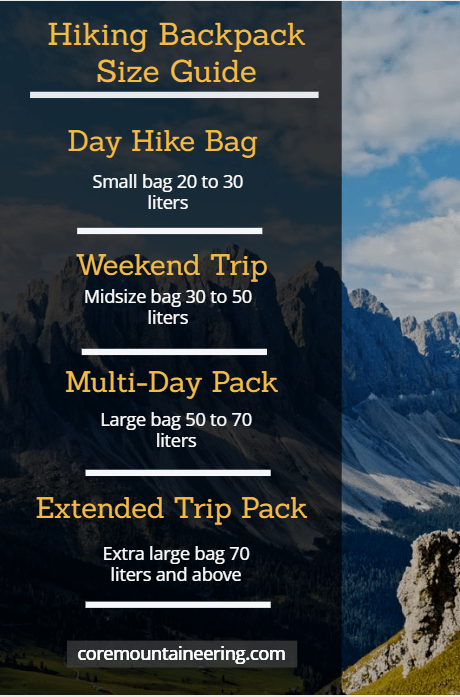Backpacking can be an exciting and challenging outdoor activity, but carrying a heavy backpack can quickly turn a fun adventure into a painful and exhausting experience.
It is essential to know how much weight you should carry on a hike to ensure that you don’t strain your body or become overly fatigued. In this article, we will discuss how to determine if your backpack is too heavy, what is base weight and pack weight, how to reduce your backpack weight, and how heavy your backpack should be per day of hiking.
How Do I Know If My Backpack Is Too Heavy?

Carrying too much weight on your back can cause a range of physical problems, from back pain to blisters to muscle strain. Here are some signs that your backpack may be too heavy:
- You struggle to lift it: If you find lifting your backpack off the ground challenging, it is likely too heavy for you.
- You feel off-balance: If you feel like your backpack is pulling you backward, it is a sign that the weight distribution is not balanced correctly.
- You’re out of breath: If you are out of breath or feel short of breath while carrying your backpack, it is a sign that you’re carrying too much weight.
- Your shoulders and back ache: If you have pain in your shoulders, neck, or back, it is a sign that your backpack is too heavy and putting undue strain on your body.
Testing Your Backpack Weight
To ensure that your backpack is not too heavy and easy to carry, it’s crucial to perform practical tests before hitting the trail. Begin by loading your backpack with the items you plan to take on your adventure and walk around on flat surfaces for about 20 minutes. This will allow the weight to settle into your shoulders and back and also give you the opportunity to get some tasks done from your to-do list.
Next, test your backpack by taking it up and down stairs, if possible. This test puts one leg at a time under pressure and checks if you can climb and descend a flat and even staircase without too much strain.
Finally, take your backpack outside and walk around the block or do some light outdoor activities such as mowing the lawn. This will help you simulate trail conditions while not being as challenging as the actual trail.
If you experience any of the previously mentioned signs of an overweight backpack during these simulations, it’s a clear indication that the same issues will arise on the actual trail. At this point, it’s time to learn how to reduce the weight of your backpack.
What Is Base Weight And Pack Weight?
To better understand how much weight you should carry, it’s essential to understand the difference between base weight and pack weight.
Base weight refers to the weight of your backpack without any food, water, or fuel. This weight includes your tent, sleeping bag, stove, and other essential backpacking gear, but no consumables.
Pack weight refers to the total weight of your backpack, including your base weight, food, water, fuel, and any additional gear you decide to bring.
What Is the Ideal Backpack Base Weight?
Ideally, your backpack base weight would be 10-15% of your body weight, with an additional 5% for consumables depending on the distance of your trip, the difficulty of the trail, and overall time away from resources.
For most people, this translates to a backpacking base weight of between 10 to 20 lbs, excluding food and water. This weight range is ideal for ensuring that your backpack is comfortable to carry while providing all the necessary gear for your adventure.
Is 10lb Base Weight Good?
Since each person and hike is unique, there is no universal standard to follow. However, many backpackers agree that an “ultralight” base weight is 10 lbs or less. Achieving a sub-10lb base weight can be challenging and costly, which may discourage some backpackers.
Does Backpacking Base Weight Include Clothes?
The base weight of your backpack consists of all items except food, water, fuel, and the clothes that you wear throughout the day. However, I like to factor in the weight of any clothing items that you don’t wear on the first day of your hike, especially if you anticipate cold or wet conditions. Such items will be stored in your backpack and worn only when necessary.
Additionally, the base weight includes the weight of containers for water and fuel, as well as any other relevant items that you carry for the entirety of your hike.
How to Reduce Your Backpack Weight
Many hikers and backpackers recognize the benefits of carrying a lighter load. It can make traveling faster, further, and more comfortable. Nevertheless, it’s important not to compromise your safety by cutting corners on essential items such as a first-aid kit and backpacking essentials. You can opt for lightweight versions of these items, but it’s not advisable to leave them out completely.
If you’re looking to make your backpacking trip more comfortable and efficient, lightening your load is a great place to start.
10 Tips to Lighten Your Backpacking Load:
- Pack only the essentials: Only bring the gear that you need for your trip. Consider the climate, terrain, and length of your hike when deciding what to pack.
- Choose lightweight gear: Invest in high-quality lightweight gear, such as a down sleeping bag or a lightweight tent, to reduce the weight of your base gear.
- Minimize packaging: Remove unnecessary packaging from food, toiletries, and other items you bring to reduce the weight of your pack.
- Share gear: If you’re hiking with a partner, consider sharing gear to reduce the weight of both of your packs.
- Pack your gear efficiently: Use compression sacks and packing cubes to save space. While packing down your gear may not inherently reduce the overall weight, it can help with movement efficiency and give a perceived weight reduction.
- Wear your heaviest gear close to your body: Part of packing efficiently is knowing how to distribute the weight. You want the heaviest items near your body. This will help to distribute the weight evenly. Also, try wearing layers so not all clothing is in your bag.
- Ditch the heavy stuff: Now that you have minimized, and packed efficiently, take inventory of your remaining heavy items. If you can live without it, leave it at home, or consider upgrading the item to something more lightweight.
- Consider renting gear: This is a great option if you only need gear for a short trip. Do a search for outfitters and gear supply locations near your journey. They often offer gear for rent that may only be needed for a portion of the trip.
- Be prepared to compromise: You may not be able to have everything you want, but you can still have a great trip by being prepared to compromise.
- Plan ahead and only pack what you need: This is the most important tip. If you don’t need it, don’t pack it! Taking stock of the journey that lies ahead and what are truly essential pieces of gear to accomplish your goal will provide you with insight for reducing your pack weight.
Consider renting gear to test it out or only use it once. Check out our article, Rent Gear Online: We Called The best 7 Places & Got Quotes.
How Heavy Your Backpack Should Be Per Days Hiking
The weight of your backpack depends on various factors, such as your fitness level, the length of your hike, and the terrain you’ll be hiking on. As a general rule, your backpack should not exceed 20% of your body weight. However, this number can vary depending on your fitness level and the difficulty of your hike.

For optimal joint protection and comfort, it’s recommended to carry only 10-15% of your body weight in your backpack, fully loaded with food and water. While the maximum weight limit for a backpack, including food and water, is set at 20% of your body weight, it’s better to stay within the lower range for long-distance hikes.
To help you estimate how heavy your backpack should be per day of hiking, we’ve created this rough guide:
| Type of Hike | Distance Range | Weight Range (in pounds) | Recommended Gear |
| Easy Hikes | 2-4 miles | 10-15 | Comfortable shoes, sunscreen, hat, water bottle, snacks |
| Moderate Hikes | 5-7 miles | 15-20 | All items for easy hikes, plus a light backpack and a first aid kit |
| Challenging Hikes | 8-10 miles | 20-25 | All items for moderate hikes, plus a headlamp, map, and extra clothing |
| Multi-day Hikes | n/a | 25-35 | All items for challenging hikes, plus camping gear, food, and a water filtration system |
Remember, these are just rough estimates, and the weight of your backpack will vary depending on your individual needs and the specific details of your hike.
Choose Your Backpacking Gear Wisely
When planning your next backpacking or trekking adventure, it’s important to consider the weight of your backpack. With so many backpacks, daypacks, rucksacks, and travel packs on the market, it can be overwhelming to choose the right one for your needs. From internal frame packs like the Osprey Atmos to external frame backpacks like the Kelty Trekker, backpacks come in all shapes and sizes to accommodate different types of trips.
Factors such as the length of your trip, the type of terrain you’ll be traversing, and the weather conditions you’ll encounter all play a role in determining the weight of your backpack.
If you’re backpacking in the alpine or backcountry, you’ll need to carry waterproof tents, sleeping bags, jackets, trekking poles, and other hiking gear. If you are day hiking, a lightweight daypack with hydration and ventilation features may be sufficient.
Regardless of the type of backpack you choose, it’s important to pay attention to the details such as the hip belt, shoulder straps, sternum strap, ventilation, and compartment layout. A properly fitting backpack with a contoured frame, padded straps, and an adjustable hip belt can help distribute the weight evenly and reduce the strain on your back and hips.
When packing your backpack, use compression straps, stuff sacks, and packing cubes to organize your gear and reduce the bulk. Side pockets, top loading compartments, and waist belt pockets provide easy access to essential items such as a water bottle, flashlight, snacks, and a first aid kit.
So, how much will your backpack weigh on your next trip? It depends on the factors mentioned above. Consider your itinerary and packing list, and aim for a manageable weight that won’t leave you feeling weighed down or fatigued.
Want to find the best hiking backpack? Please take a look at our guide, How to Choose the Right Hiking Backpack.
How Much Weight I Pack For A Multi-Day Hike
Without going into too many details about the specific gear I have found my method effective at achieving a desirable weight for multi-day backpacking trips.
First, I stick to the recommended base weight numbers above, aiming for no more than 10-15% of my body weight.
Next, I add my consumables, looking for no more than another 5-7% increase in weight. I typically use a “diminishing” food supply method for this approach, as described below.
Once I have that in place, I go through the trip plans and decide if there is any gear that can be left behind or shipped ahead to a gear cache…perhaps even looking to rent it from a gear shop as needed.
Food and Water Plan
Generally, a reasonable amount of food to bring is 1.5 to 2.5 pounds per person per day, or 2,500 to 4,500 calories, depending on factors such as your size, weight, and level of physical activity.
However, I like to use an alternative approach known as a “diminishing” food plan. This involves packing a higher calorie count on the first day, say 4,500 calories, and gradually reducing the amount of food each day, while ensuring you always have enough to recover from the day’s exertion.
For example, on a four-day trip, you might pack 4,500 calories for the first day and 2,500 for the remaining days, taking advantage of the fact that you’ll likely have more energy on the first day. I also typically pack high-density whole foods for the first day, while my remaining meals might be lighter freeze-dried options. Regardless of your strategy, it’s crucial to bring plenty of water.
Pack Light, Hike Right: What’s the Average Backpack Weight for Your Next Adventure?
Carrying a heavy backpack on a hike can quickly take the fun out of your adventure. By understanding what base weight and pack weight are and knowing how to reduce your backpack, you can make sure that you are carrying a comfortable and safe load on your next hike.
Remember to prioritize the essential gear and carefully consider each item you pack. If you’re unsure about the weight of your backpack, it’s always a good idea to weigh it and compare it to the recommended weight ranges for the type of hike you’re taking.
We would love to hear about your experiences with backpack weight and how you’ve managed to pack light on your hiking trips. What are some strategies you’ve used to reduce your pack weight, and where are you planning to hike next? Share your thoughts and tips in the comments below!
For tips on what’s needed the day before you go hiking, check out our article, How to Prepare for a Hike the Night Before.










